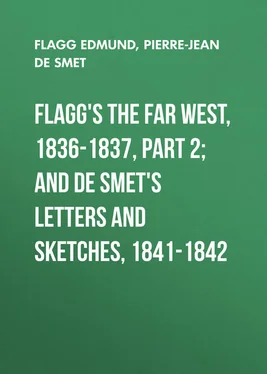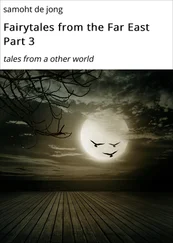Edmund Flagg - Flagg's The Far West, 1836-1837, part 2; and De Smet's Letters and Sketches, 1841-1842
Здесь есть возможность читать онлайн «Edmund Flagg - Flagg's The Far West, 1836-1837, part 2; and De Smet's Letters and Sketches, 1841-1842» — ознакомительный отрывок электронной книги совершенно бесплатно, а после прочтения отрывка купить полную версию. В некоторых случаях можно слушать аудио, скачать через торрент в формате fb2 и присутствует краткое содержание. Издательство: Иностранный паблик, Жанр: foreign_antique, foreign_prose, на английском языке. Описание произведения, (предисловие) а так же отзывы посетителей доступны на портале библиотеки ЛибКат.
- Название:Flagg's The Far West, 1836-1837, part 2; and De Smet's Letters and Sketches, 1841-1842
- Автор:
- Издательство:Иностранный паблик
- Жанр:
- Год:неизвестен
- ISBN:нет данных
- Рейтинг книги:4 / 5. Голосов: 1
-
Избранное:Добавить в избранное
- Отзывы:
-
Ваша оценка:
- 80
- 1
- 2
- 3
- 4
- 5
Flagg's The Far West, 1836-1837, part 2; and De Smet's Letters and Sketches, 1841-1842: краткое содержание, описание и аннотация
Предлагаем к чтению аннотацию, описание, краткое содержание или предисловие (зависит от того, что написал сам автор книги «Flagg's The Far West, 1836-1837, part 2; and De Smet's Letters and Sketches, 1841-1842»). Если вы не нашли необходимую информацию о книге — напишите в комментариях, мы постараемся отыскать её.
Flagg's The Far West, 1836-1837, part 2; and De Smet's Letters and Sketches, 1841-1842 — читать онлайн ознакомительный отрывок
Ниже представлен текст книги, разбитый по страницам. Система сохранения места последней прочитанной страницы, позволяет с удобством читать онлайн бесплатно книгу «Flagg's The Far West, 1836-1837, part 2; and De Smet's Letters and Sketches, 1841-1842», без необходимости каждый раз заново искать на чём Вы остановились. Поставьте закладку, и сможете в любой момент перейти на страницу, на которой закончили чтение.
Интервал:
Закладка:
"Although the English shot near 2000 muskets, they killed but 30 and wounded 40. They spared not the church, which, after they had indignantly profaned its sacred vases and the adorable body of Jesus Christ, they set on fire. They then retired with precipitation, having been seized with a sudden panic. The Indians returned immediately into the village; and their first care, while the women sought plants and herbs proper to heal the wounded, was to shed tears upon the body of their holy missionary. They found him pierced with a thousand shot, his scalp taken off, his skull fractured with hatchets, his mouth and eyes filled with dirt, the bones of his legs broken, and all his members mutilated in a hundred different ways.
"Such is the account of the fall of Rasle , by a brother of the faith; a deplorable picture, by whomsoever related! Of the truth of its main particulars there can be no doubt, as will be seen by a comparison of the above translation with the account preceding it. There were, besides Mogg , other chief Indians who fell that day: 'Bomazeen, Mogg, Wissememet, Job, Carabesett, and Bomazeen's son-in-law, all famous warriors.' The inhumanity of the English on this occasion, especially to the women and children, cannot be excused. It greatly eclipses the lustre of the victory." Drake's Book of the Indians , b. iii., c. 9. – Flagg.
Comment by Ed. Instead of the French and Indian War (1754-1763), Flagg is doubtless referring to Queen Anne's War (1702-1713).
A large amount of valuable but scattered documentary and secondary information concerning this massacre and the causes leading to it may be found under captions "Norridgewock" and "Rasle" in indexes to Maine Historical Society Collections , and Documents relative to Colonial History of State of New York (Albany, 1854-61). See also William Allen, History of Norridgewock (Norridgewock, 1849).
42
Prunus Americana. – Flagg.
43
Indian Date, by the French called Placminier, Diosporus Virginiana . – Flagg.
44
Morus Rubra and Alba . – Flagg.
45
Prunus Cerasus Virginia. – Flagg.
46
Custard apple, Annona glabra . – Flagg.
47
Breckenridge. – Flagg.
Comment by Ed. Henry Marie Brackenridge, Views of Louisiana , p. 60.
48
For a sketch of Prairie du Rocher, see A. Michaux's Travels , in our volume iii, p. 70, note 133. – Ed.
49
This tradition does not appear to have been noticed in the local histories of the region. – Ed.
50
For sketches of Forts Presqu' Isle (present site of Erie), Machault (on Allegheny River), Duquesne (present site of Pittsburg), Le Bœuf (near the present town of Waterford, Pennsylvania), St. Joseph (Michigan), and Ouiatonon (on the Wabash), Detroit, and the fort on the Maumee River, see Croghan's Journals , in our volume i, p. 101, note 62; p. 102, note 64; p. 85, note 45; p. 102, note 65; p. 117, note 85; p. 55, note 18; and p. 122, note 87, respectively. On Forts Chartres (on the Mississippi) and Massac (on the Ohio), see A. Michaux's Travels , in our volume iii, p. 71, note 136, and p. 73, note 139, respectively. Fort Massac was the only one upon the Ohio. Juchereau's post was erected (1702) at the confluence of the Ohio and the Mississippi, but was soon abandoned. – Ed.
51
Prunus Angustifolia. – Flagg.
52
Immediately after the erection of Fort Chartres (1720), a village sprang up and the Jesuits established there the parish of Ste. Anne de Fort Chartres. The earliest records of this parish now extant, bear the date 1721. – Ed.
53
Philip Pittman, who visited Fort Chartres in 1766, says in his Present State of the European Settlements on the Missisippi (London, 1770), p. 46, concerning Fort Chartres: "In the year 1764 there were about forty families in the village near the fort, and a parish church, served by a Franciscan friar, dedicated to St. Anne. In the following year, when the English took possession of the country, they abandoned their houses, except three or four poor families, and settled at the villages on the west side of the Missisippi, chusing to continue under the French government."
In a personal letter dated November 3, 1762, Louis XV deeded to Charles III of Spain all of the French territory in North America lying to the west of Mississippi River; see Shepherd, "Cession of Louisiana to Spain," in Political Science Quarterly , xix, pp. 439-458; also Thwaites, France in America (New York, 1905), pp. 272-275. Napoleon coerced Charles IV to retrocede Louisiana to France, by the secret treaty of St. Ildefonso, signed October 1, 1800. Three years later (April 30, 1803), Napoleon sold Louisiana to the United States for $15,000,000.
Captain Louis St. Ange de Bellerive formally surrendered Fort Chartres to Captain Sir Thomas Sterling on October 10 (not July), 1765, went to St. Louis, and entering the Spanish service was placed in command of the little garrison there, composed almost wholly of his French compatriots who had removed thither from the Illinois. For a sketch of St. Ange, see Croghan's Journals , in our volume i, p. 138, note 109. – Ed.
54
Sir Thomas Sterling (1733-1808), commissioned captain of the 42nd Highlanders (1757), served with his men in the conquest of Canada, and the capture of Martinique (1759) and Havanna (1762). Having taken command of Fort Chartres in October, 1765, he was relieved of this unpleasant duty, December 4 of the same year, by Major Robert Farmer, heading a detachment of British foot from Mobile. Sterling and his regiment set sail from America (1767), but returned (1776) and served with distinction at the storming of Fort Washington (1776) and of Elizabethtown (1779). He was wounded at Springfield (Massachusetts) in June, 1780. Promoted through the various ranks, he was made a royal aide-de-camp of the king and in turn a colonel (February 19, 1779), major-general (November 20, 1782), and general (January 1, 1801). He became baronet of Andoch on his brother's death, July 26, 1799. Several Illinois historians strangely persist in killing Sterling in 1765, shortly after he took command at Fort Chartres. See Dictionary of National Biography ; and Documents relative to Colonial History of New York , vii, p. 786.
Lieutenant-Colonel John Wilkins, appointed captain of the 55th foot (1755) and then major (1762), commanded at Niagara. In 1763, while marching to relieve Detroit, he was attacked by Indians and forced after heavy losses to retreat to Fort Schlosser. Later, he made an unsuccessful attempt by water, but was caught in a disastrous storm. In August, 1764, Wilkins was promoted to the majorship of the 60th, and in the following January was appointed lieutenant-colonel of the 18th Royal Irish with seven companies. In May, 1768, he was ordered from Philadelphia to Fort Pitt, and thence to Fort Chartres. His administration was unpopular, and grave charges – notably misappropriation of land and funds – were brought against him. He was suspended in 1771, set sail for Europe the following year, and either died or left the army (1775). See Historical Magazine , viii, p. 260; and Documents relative to Colonial History of New York , viii, p. 185. – Ed.
55
Subjoined is a copy of the preliminary proceedings of the first regular court of justice held in Illinois while under the British government. It purports to be transcribed from the state records, and first appeared in a Western newspaper. It lays before the reader a view of the subject, which the most graphic description would fail to present.
Читать дальшеИнтервал:
Закладка:
Похожие книги на «Flagg's The Far West, 1836-1837, part 2; and De Smet's Letters and Sketches, 1841-1842»
Представляем Вашему вниманию похожие книги на «Flagg's The Far West, 1836-1837, part 2; and De Smet's Letters and Sketches, 1841-1842» списком для выбора. Мы отобрали схожую по названию и смыслу литературу в надежде предоставить читателям больше вариантов отыскать новые, интересные, ещё непрочитанные произведения.
Обсуждение, отзывы о книге «Flagg's The Far West, 1836-1837, part 2; and De Smet's Letters and Sketches, 1841-1842» и просто собственные мнения читателей. Оставьте ваши комментарии, напишите, что Вы думаете о произведении, его смысле или главных героях. Укажите что конкретно понравилось, а что нет, и почему Вы так считаете.












